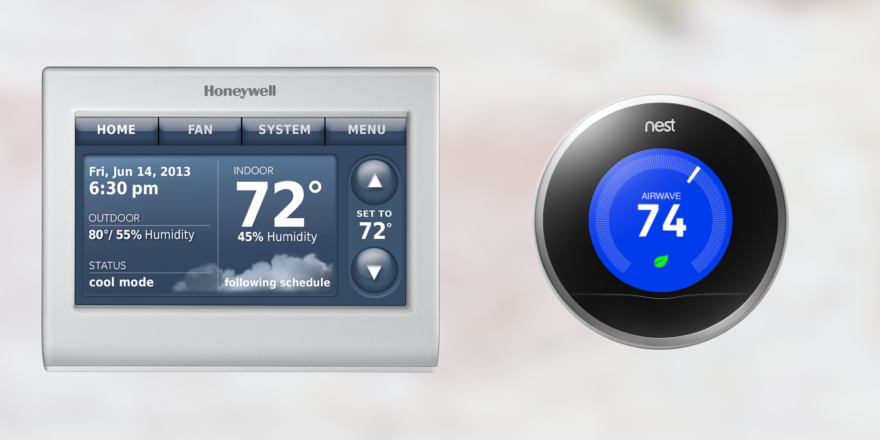As technology continues to advance, so too do the applications of “smart” devices. It’s now more realistic than ever before to build a house that’s totally automated and anticipates your whims. Light bulbs that react to your presence, security systems that provide real-time updates, and smart hubs to control each aspect of your home environment make for the ultimate in comfort and convenience.
Smart homes had a reputation for being relatively expensive, but are now getting more and more affordable. Though there’s a decent amount of setup involved to achieve a comfortable level of automation and convenience, the setup is well worth the cost. And automating your home may actually save you money in the long run. Which brings us to smart thermostats.
We’re going to look at two popular smart thermostats: the Honeywell Smart Thermostat and the Nest. We’ll take a look at the major differences, and try to give you a sense of which device is right for your needs. So, let’s get into it!
Honeywell Smart Thermostat vs. Nest — Differences
-
Difference #1: C-wire – One big difference between the Honeywell Smart Thermostat and the Nest is the way in which they are powered.
Most thermostats are powered via “C-wire”, and both the Nest and Honeywell model primarily power through this method.
The difference between the two devices, however, lies in the fact that the Nest thermostat offers an alternative charging method. While the Honeywell Smart Thermostat is only able to function with a C-wire, the Nest also features an internal, rechargeable battery which it can run off of in absence of this wire.
The Nest charges its internal battery via periodic “pulses” to your heating system using the heating and cooling wires. The downside to this method, however, is that these pulses can sometimes cause some weird boiler behavior that is less than efficient to say the least!
If at all possible, power both devices via C-wire. But we give Nest the edge in this difference thanks to its availability of an additional power option.
-
Difference #2: Geofencing – One unique feature that Nest offers is the idea of “Geofencing”.
Geofencing refers to the ability of the thermostat to create a “fence” of sorts around the area. This fence allows Nest to adjust temperature as needed based on whether or not people are actually in the room. It’s easy to see how adjustable temperature based on whether it’s actually needed can lead to major energy savings over time. The Nest can detect your presence either with its built-in sensor or with the GPS on your phone.
Unfortunately, the Honeywell Smart Thermostat lacks geofencing, putting the Nest ahead, yet again, in this category.
-
Difference #3: Remote Sensors – Remote sensors are also a nice perk for a thermostat to have. Being able to have your device pick up the temperature in more than one room and adjust accordingly is a nice feature.
Unfortunately, neither thermostat has dedicated remote sensors. The Nest integrates with Nest Protect Smoke Plus Carbon Monoxide Detectors to provide additional temperature monitoring, but these alarms are a bit expensive. However, if you’re interested in upgrading your smoke detectors, then Nest Protect is a perfect two-in-one solution that can more than make up for the cost.
If you’re interested in equal heating/cooling distribution among rooms, then the ecobee4 thermostat might be a better option for you. Its bundle already comes with one sensor (with extras for purchase), plus it has Amazon Alexa voice control built-in. Learn more in our comparison: Ecobee3 vs. Ecobee4 vs. Nest — What’s the Difference?.The Honeywell Smart Thermostat doesn’t have any support for sensors, however, so the Nest has a small advantage even if their sensors are a bit inaccessible.
Update 05/05/18: You can now buy the Nest Temperature Sensors to even out the temperature between rooms in your home. The Nest Temperature Sensors work only with the Nest Learning Thermostat Gen 3 and the Nest E Thermostat.
No products found.
-
Difference #4: Bluetooth Low Energy – Another advantage that Nest has over Honeywell is support for Bluetooth Low Energy. This unique feature allows Nest to transmit and receive data over bluetooth rather than wi-fi, saving battery power while providing blazing fast data transmission speeds.
The Honeywell Smart Thermostat only functions over Wi-Fi.
-
Difference #5: Display – This comparison may have started to look a little one-sided, but the Honeywell Smart Thermostat does have an advantage when it comes to display.
The device features a bright, easy-to-read touch screen with an adjustable background.
The Nest has no touchscreen, but it does have a unique “Farsight” feature that turns on the display when movement is detected within 20 feet. This is a nice perk that makes it easy to read the temperature at a glance while saving power when the display is not needed.
-
Difference #6: Compatibility – If you already have a smart home setup, perhaps the most important consideration in this “battle of the thermostats” is compatibility with your chosen smart home system. There are some differences here that may very well make the decision for you.
Honeywell Smart Thermostat has the advantage here, and remains one of the most highly-compatible devices on the market. It supports Amazon Alexa, Google Home, Wink, IFTTT, Samsung SmartThings, Apple HomeKit and a whole lot more. Check out the full list here for a more comprehensive list of compatibility.
The Nest, on the other hand, is a little less compatible. This thermostat currently only supports Amazon Alexa, Google Home, Wink, and IFTTT.
-
Difference #7: Size – There’s a small difference in size between the two models with the Nest (3.3″ x 3.3″ x 1.21″) being slightly smaller than the Honeywell Smart Thermostat (4.5″ x 3.5″ x 1″). The difference is negligible, but is worth mentioning. The Honeywell’s touch screen makes the model a little bit bigger, but that’s more than worth it in the end.
-
Difference #8: Color – Another consideration to take into account is the color. While perhaps not an aspect to base the decision off of, it’s always nice when devices look nice in your home.
The Nest pulls ahead in this category, with white, copper, black, and stainless steel finishes. The Honeywell Smart Thermostat offers only one option — a silverish white.
-
Difference #9: Energy Saving Reports – One of the biggest features of any smart thermostat is the ability to save energy.
With the Nest, you never have to program a schedule. The company markets these devices as “learning” thermostats. There’s technology in place to learn your schedule and the temperature you like, and the thermostat automatically adjusts accordingly. There’s the option to program it manually, but for the most part that’s not needed.
Additionally, the Nest provides energy usage reports. These reports not only detail how much energy you have spent, but also how efficiently this energy was used. By default, the report through the app shows information for the previous 10 days, but you can also sign up for a monthly energy report.
The Honeywell Smart Thermostat doesn’t learn your schedule, but it does come with a recommended energy efficient program pre-installed. However, the Honeywell does learn about your heating and cooling system and how long it will take to reach a specific temperature. This means that your system will be turned on at exactly the right time to prepare the room for your arrival — adding convenience and saving energy over time. Unfortunately, the thermostat lacks the energy reporting feature of the Nest.
-
Difference #10: Warranty – With a thermostat that’s responsible for the comfort of your home, it’s important that the attached warranty will cover the equipment for a reasonable amount of time.
Nest offers a warranty for two years, outclassing the Honeywell Smart Thermostat’s which only offers one year.
If you’re worried about adding this new device to your home, going with the option with longer coverage may make for better peace of mind.
-
Difference #11: Price – Before making a final judgement, it’s important to look at one final aspect of the two thermostats: the price. After all, what use are a bunch of extra features if you don’t want to shell out for them?
The Honeywell is the more economical purchase whereas the Nest, offering arguably more features, is a bit more expensive.
Whether the additional price is worth the extra features is going to be an individual decision.
Honeywell Smart Thermostat vs. Nest — Comparison Chart
| Honeywell Smart Thermostat | Nest Learning Thermostat | |
|---|---|---|
| Heating Stages | 2 | 3 |
| Dimensions | 4.5” x 3.5” x 1” | 3.3” x 3.3” x 1.21” |
| Hardware color | White | White, Copper, Black, Stainless Steel |
| Bluetooth LE | No | Yes |
| Wi-Fi | Yes | Yes |
| Remote sensors | No | Nest Protect Nest Temperature Sensor |
| Humidity sensor | Yes | Yes |
| Power (if no C-wire present) | Requires C-Wire | Heating/Cooling Wires + Battery |
| Learns habits over time | No | Yes |
| Works with Amazon Alexa | Yes | Yes |
| Google Assistant support | Yes | Yes |
| Works with Wink | Yes | Yes |
| HomeKit-enabled | Yes | No |
| Works with SmartThings | Yes | No |
| iOS App | Yes | Yes |
| Android App | Yes | Yes |
| Web Access | Yes | Yes |
| Free monthly energy reports | No | Yes |
| Warranty (years) | 1 Year | 2 Years |
Honeywell Smart Thermostat vs. Nest — Our Thoughts

All in all, both thermostats offer their own sets of benefits and drawbacks. It’s never been easier to set up smart tech in your home, and both of these devices offer features that will add convenience, comfort, and energy savings to your home environment.
It’s difficult to declare one thermostat as “better” because they’re best suited for different people. The Nest Learning Thermostat offers more control and options, but is more expensive. The Honeywell Smart Thermostat offers a less fully-featured — yet still comprehensive — experience, and is a better budget buy.
We’ve done our best to paint an accurate picture of the similarities and differences, but at the end of the day the decision is largely a personal one. Regardless of the choice you make, you’ll be well on your way to a smarter, more efficient home.
Last update on 2024-04-19 at 14:11 / Affiliate links / Images from Amazon Product Advertising API




